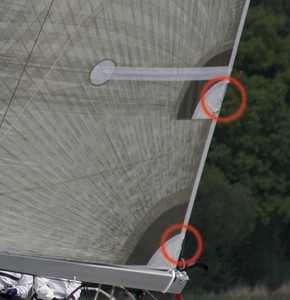Leech Lines and How to Make your Sails Last Longer
by Charles Ulmer , UK-Halsey Sailmakers on 19 Dec 2007

DON’T leave your sails to flutter SW
Right leech line handling can add years of life to your sails - Adam Loory this week shares some secrets:
All sails today come equipped with leech lines or cords that enable sailors to stop that annoying flutter between the batten pockets on your mainsail or up the entire leech of your genoa. This flutter usually gets more pronounced as the wind increases and in some cases can get so noisy, it becomes difficult to hear anything else.
In the days of Dacron sails, adjusting the leech line was a matter of eliminating a nuisance, nothing more. Today many cruising sailors and virtually all racing sailors use laminate sails, which places a new importance on properly adjusting the leech line to prevent damage to the sail.
For example, let's consider the leech area in your mainsail between the clew and the lowest batten pocket (see photo). At the very edge of the sail, there is a Dacron tape that encloses the leech line. This tape usually extends 1-2' into the sail and then you are left with whatever laminate the sail is made of. When the leech flutters, the laminate bends or hinges back and forth just inside of this tape and as we have all seen, this frequency of this bending can amount to hundreds of times per minute in a stiff breeze.
To get an idea of what this is doing to the laminate, straighten out a paper clip and flex it back and forth a couple of times. The result is obvious! Of course the metal in a paper clip isn't nearly as flexible as a sail laminate but Mylar film and some high modulus yarns used in racing sails do break down rather quickly when flexed.
So we'd like to offer some words of advice:
1. Pay attention to the leech of your sails and adjust the leech line when the edge of the sail starts to flutter.
2. Make sure the leech lines and cleats are adequate for the job. For instance they should be a low stretch line and of sufficient diameter to hold in the cleat. On large genoas, you may need a mechanical advantage (2 or 3:1 or even a small tackle). If your leech line cleat gets stripped and fails to hold the leech line, tighten the leech line and then tie it off until you can get the cleat replaced.
3. Your mainsail leech line should be able to be adjusted when the sail is reefed; notice the cleat just above the reef in the picture. Cleats on the leech of the sail cannot be adjusted when the boom is eased out over the water; therefore, some offshore mains have two leech lines, where the second one is led over the top of the sail and down the luff to a cleat at the tack.
For all information about UK-Halsey, go to the
UK-Halsey website
If you want to link to this article then please use this URL: www.sailworldcruising.com/40063